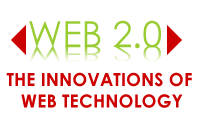 We’ve all experienced and used at least one or two of the most popular internet applications in the web like Google, blogging, Flickr, and search engine optimization, but we don’t realize just how far the innovations have gone unless we compare it to the older versions of such applications like DoubleClick and mp3.com. Web 2.0 refers to the innovations of the World Wide Web in which sites and services of all kinds have sprouted in order to manipulate or utilize the web as a unique platform. Coined by the O’ Reilley Media back in 2003, it basically emphasizes on the progression and transition of web 1.0 applications into modern versions that include active participation from online communities, branch-like spread of information, and the ability to share all kinds of interests through the use of sites. Interests like imaging, video sharing, blogging, and even business-related activities are now fully accessible in today’s version of the World Wide Web.
We’ve all experienced and used at least one or two of the most popular internet applications in the web like Google, blogging, Flickr, and search engine optimization, but we don’t realize just how far the innovations have gone unless we compare it to the older versions of such applications like DoubleClick and mp3.com. Web 2.0 refers to the innovations of the World Wide Web in which sites and services of all kinds have sprouted in order to manipulate or utilize the web as a unique platform. Coined by the O’ Reilley Media back in 2003, it basically emphasizes on the progression and transition of web 1.0 applications into modern versions that include active participation from online communities, branch-like spread of information, and the ability to share all kinds of interests through the use of sites. Interests like imaging, video sharing, blogging, and even business-related activities are now fully accessible in today’s version of the World Wide Web.
Lately, the concept of web 2.0 has become more associated with e-commerce, online marketing, and other business-related activities that take advantage of the power of the internet such as the use of search engine optimization, Google Adwords or other online advertising platforms, and the like. It has also worked as one of the best tools to increasing traffic, otherwise known as online visitors to a website, since it follows a series of websites that involve large communities of people that engage in conversation, sharing of information, etc. Overall, web 2.0 has boosted both creativity and communication among online users and it has defined the newest trends in web technology.
“We now have more varied choices of communication technology than Socrates ever imagined—television, Web sites, movies, video blogging, and
photo essays. Printed text has lost its monopoly to multimedia. For students to be effective communicators in the 21st century, they need to be sophisticated in expressing ideas with multiple communication technologies, not just the written word. Digital storytelling allows students to use multimedia tools in a sophisticated fashion while capturing the joy of creating and sharing their stories.”
Bernajean Porter, Beyond Words: The Craftsmanship of Digital Products, ISTE article, Learning and Leading with Technology, May 2006.


Comments
2 responses to “Web 2.0 – The innovations of the web technology”